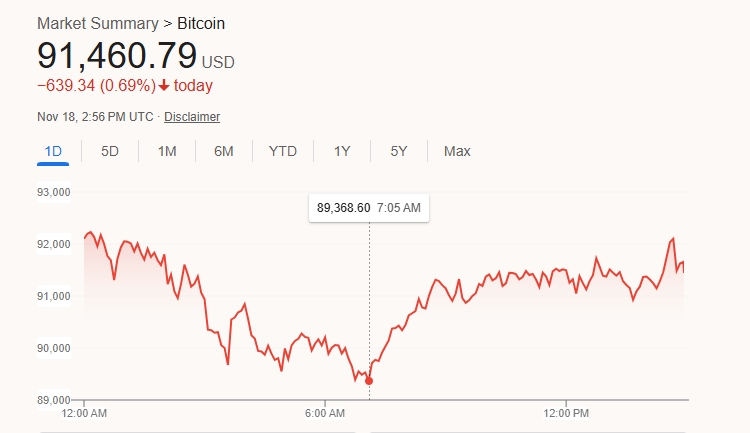Bitcoin falls to $89,369 as crypto market loses $1 trillion in six weeks amid tech bubble fears

The crypto market hasn’t seen a stretch like this in months. Bitcoin slipping into the $89,000s has pulled sentiment into a darker corner of 2025, shaking both retail traders and institutional desks. As of 7:05 AM EST, Bitcoin fell to its lowest price of the year at $89,368.60.
In just six weeks, a trillion dollars in crypto value has vanished, and the drop is colliding with fears that extend well past digital assets — fears tied to the broader tech cycle, AI valuations, and a growing sense that risk appetite is shifting all at once.
According to CoinGecko’s tracking of more than 18,500 tokens, more than $1tn has been wiped from crypto in roughly 40 days. The sharp reversal began in early October after Bitcoin’s peak near $126,000, and the market has been sliding ever since. Traders are treating this as more than a routine correction. The mood feels heavier, shaped by macro pressures, abandoning liquidity, broken technical levels, and an uneasy comparison to previous tech bubbles. Bitcoin has recovered some ground and is now trading at $91,460.79.

Bitcoin falling below $90,000 pushed sentiment over the edge. It’s now sitting at its lowest point since April after losing nearly 30% from its highs. Strong economic data in the U.S. has kept interest rates elevated longer than expected, and rising yields are draining enthusiasm for high-beta assets. Investors are choosing safety. Crypto is paying the price.
What’s happening in the broader crypto market?
Institutional enthusiasm has cooled as well. The spot Bitcoin ETFs that once fueled record inflows have slowed to a crawl, with some funds now posting net outflows. Large holders have been moving coins back onto exchanges, signaling that either profit-taking or defensive preparation is underway. This shift has weakened the support layer that carried Bitcoin through the first half of 2025.
Altcoins are sliding even harder. Ether, Solana, Binance Coin, and XRP are all being hit with bigger percentage drops as traders unwind leverage and step away from speculative tokens first. The broad market has now shed more than a trillion dollars during the downturn. Stablecoin flows show traders rushing into cash-like positions, a classic signal that nerves are rising.
Right now, Bitcoin is stuck in a fragile range between $88,000 and $90,000. If that range gives way, analysts warn that the next cluster of support sits closer to $75,000–$78,000. The $85,000 zone could offer a brief pause, but it may take stronger improvement in macro signals — or renewed ETF interest — to rebuild confidence. A recovery above $92,000–$95,000 would help stabilize sentiment, giving the market a chance to regroup before the psychological $100,000 line comes back into play.
The macro backdrop is doing Bitcoin no favors. Traders have been betting on a rate cut next month, but recent data — stubborn inflation, steady job growth, and strong consumer spending — has reduced the chance of a pivot. Higher yields usually pressure assets that rely on liquidity cycles, and Bitcoin has increasingly behaved like a high-beta tech asset. When optimism fades, it drops harder. With caution now dominating markets globally, Bitcoin is absorbing the full impact of that shift.
Investors are trimming exposure across risky assets as geopolitical tensions remain elevated. In such periods, portfolios drift toward cash, bonds, and defensive strategies. Crypto, with its volatility and thinner liquidity, experiences harsher swings when sentiment turns cautious.
Technical cracks have added fuel. Bitcoin broke through several support levels last week, including $94,000 and $92,000. When it lost the $90,000 floor, stops were triggered, and algorithm-driven selling accelerated the decline. A developing “death cross” — a short-term moving average sliding below a long-term one — has unnerved momentum traders, pushing many to close positions. With fewer active buyers and thinner order books, even moderate selling sparks outsized moves.
Market pressure deepens as Bitcoin breaks key support levels
Psychology is playing a major role. Breaking a big round number like $90,000 shifts the mood instantly. Traders who were previously confident start to fear a deeper drop, and that fear feeds more selling. Social chatter and derivatives markets multiply that effect, creating quick spirals.
Institutional behavior is changing, too. Earlier this year, large players drove Bitcoin to new highs. That tailwind has faded. Spot ETF inflows have slowed and, in some cases, flipped negative. Whales moving coins onto exchanges hint at preparation for more selling. Hedge funds and macro shops are closing or reducing positions as the path for rate cuts becomes less clear. With fewer institutional stabilizers in the market, price swings feel sharper.
The weakness goes beyond Bitcoin. Ether, Solana, XRP, and Binance Coin have all posted heavy losses, with traders exiting the highest-beta tokens early. Liquidity on many exchanges has thinned out, leading to wider spreads and exaggerated moves during selloffs. Stablecoin balances are rising, signaling that traders are stepping back and waiting for calmer conditions.
Altogether, this paints a picture of a broader retreat from speculative trading, not an isolated Bitcoin breakdown.
Bitcoin is not alone. Stocks are also feeling the pressure. According to a report from the Guardian, the FTSE 100 fell 1.2% on Tuesday, marking four straight days of declines. Europe’s Stoxx 600 dropped 1.2% as well. Asia saw deeper red numbers, with Japan’s Nikkei 225 down 3.2% and Hong Kong’s Hang Seng falling 1.7%. Global appetite for risk is clearly fading at the same time that AI-driven valuations reach new extremes.
Even industry leaders are voicing concern. Sundar Pichai warned in a BBC interview that there is “irrationality” in the current AI boom and that “no company is going to be immune, including us” if the bubble bursts. Klarna co-founder Sebastian Siemiatkowski echoed the alarm, questioning whether the massive spending on datacenters and rising AI stock valuations — including Nvidia’s climb to $4tn — can be sustained. “That makes me nervous, because of the amount of wealth that is currently automatically allocated into this trend,” he said, adding that pension funds are now tied to the same bets.
Gold, often a safe haven, is also slipping. Spot prices dipped 0.3% to $4,033.29 an ounce after hitting a one-week low earlier in the session. Expectations for a near-term Fed rate cut have faded. Without a yield, gold becomes less appealing in high-rate periods.
UBS analyst Giovanni Staunovo expects the drop to be temporary. “I would expect gold prices to bottom out soon, as I still see the Fed cutting rates several times over the coming quarters, and central banks’ diversification into gold remains strong,” he said.
Bitcoin, meanwhile, has fallen 27% during these six weeks, landing at $91,212 at one point — its weakest level since April. With the crypto market losing more than $1 trillion and global tech valuations under scrutiny, the next few weeks will be critical in determining whether this is a brief reset or the early signs of a larger unwind.




